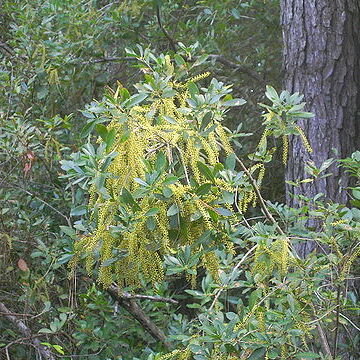Shrub or small tree, up to 7-15 m tall, sometimes multistemmed, occasionally spreading with vine-like branches, rarely branched at base. Leaf scars prominent. Stipules inconspicuous (caducous) or absent; petiole usually short (nearly subsessile), slightly winged, 0.4-1.3 cm long; blade subcoriaceous to coriaceous, oblanceolate to elliptic, occasionally linear, 2-11(-12) (including petiole) x 0.4-2.5(-3) cm, margin usually slightly reflexed, apex acute to rounded, sometimes emarginated (rarely apiculate), base narrowly cuneate to attenuate; midvein generally depressed above, prominent beneath, densely reticulate, slightly prominent or obscure above, secondary veins straight to slightly arcuate, divergent, irregularly anastomosing. Inflorescence racemose, axillary, usually near end of branches, glabrous; peduncle 0.4-1.7 cm long (before the first bract); rachis up to 14 cm long, usually somewhat ridged; often numerous flowers, erect or pendulous; bract lanceolate-subulate, 0.8-2.4(-3.5) mm long, acuminate to very acute, basally thickened and usually costate, persistent; bracteoles 2, usually above middle of pedicel, alternate or opposite, lanceolate, 1-1.5(-1.6) mm long, persistent; pedicels ascending or slightly patent, alternate or subopposite, 1.1-2 mm long (up to 4 mm when fruiting), usually pink. Flowers actinomorphic; sepals free, or basally connate, 5, pink, coriaceous, usually with basal thickening, lanceolate-ovate to deltoid, 0.6-1.5(-1.6) x up to 0.7(-1) mm, apex acute to acuminate, glabrous, persistent; petals imbricate or slightly contorted, free or shortly fused, 5, white, usually more membranaceous along margin, oblong to oblong-lanceolate or oblong-elliptic, 2(-2.4) x up to 1.1 mm, margins sometimes inrolled (giving the appearance of long acuminate), apex acute, obtuse or rounded, glabrous to rarely glandular on lower inner surface; stamens 5, about 2/3 as long as petals (always shorter), filaments flattened, 1.1-1.4 mm long, anthers terete, linear-subulate, up to 0.4 mm broad, very occasionally with mucronate tip, versatile, dehiscing longitudinally, pink or purple; nectary disc sometimes present; ovary 2-3(rarely-4)-locular, oblong to slightly ovate, wrinkled when dried, glabrous, up to 1.6(-2) mm long, ovules usually 2, pendulous from apex of locule, style 1, short, stout, stigma entire, or 2-3-lobed, corresponding to number of locules. Fruit dry, indehiscent, green immature, red (pink) at maturity, subglobose to globose or conic-ellipsoid, 2.5-(3) x up to (0.9-)2(-3) mm, usually smooth (rarely slightly rugulose), glabrous, stigma usually persistent; seeds 1 per locule, elongate.
More
Shrubs or trees, deciduous or semi-evergreen, usually much-branched from base. Leaves: petiole present; blade with prominent midrib and clearly visible lateral veins on both surfaces. Inflorescences clustered at distal ends of branchlets of previous season, produced after shoot growth of current season begins, 6-18 cm; bract persistent. Pedicels: bracteoles persistent, 2. Flowers: sepals lanceolate-ovate, apex acute to acuminate; petals ovate to ovate-lanceolate, base not clawed, apex acute; stamens 5; filaments terete, somewhat expanded basally; ovary 2-3(-4)-locular; ovules 1-3 per locule; stigma 2-3(-4)-lobed. Fruits berrylike, unwinged, ovoid to subglobose. Seeds usually absent, sometimes 1-4.
Shrubs or trees. Leaves entire, short-petioled, subcoriaceous to coriaceous. Flowers with the sepals equal; petals white, thickened and glandular medially and below the middle; stamens 5, dehiscing longitudinally, the filaments terete, subulate; styles short, 2-3-lobed. Fruit a drupe, longitudinally bisulcate or trisul-cate.
Pedicels with a pair of persistent bractlets; pet thickened and glandular at and below the middle; stamens 5, alternate with the pet; filaments terete; anthers opening longitudinally, dorsoversatile, with separate basal lobes; ovary 2–3-locular; ovules 3 per locule; fr sulcate. Monospecific.

